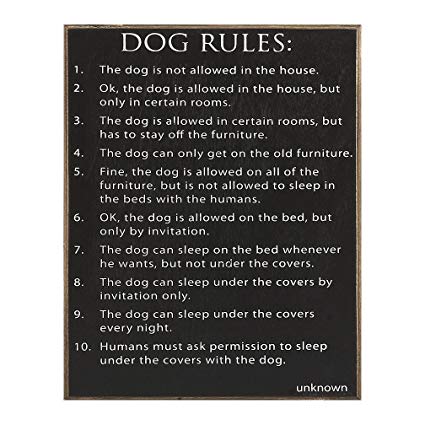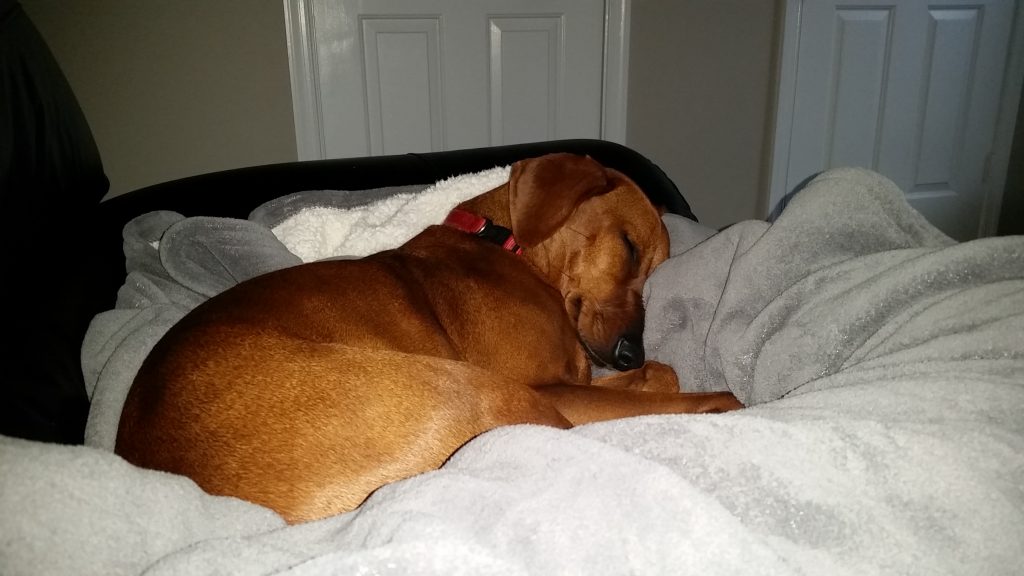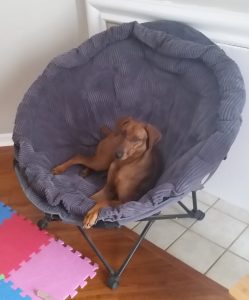Dogs with behavioral issues are not fun. However, I learned from the mistakes of my past and began laying down a firm groundwork of rules within my first week of puppy ownership for what was permissible. In my household, these are rules for my dog:
-
You must sit and stay while I prep your meals. Whining isn’t cute. You can wait patiently and quietly. You are not allowed to eat until I give you a release word.
-
If you ask to go out, you must go potty. It’s raining? Sucks for you. Pee faster and we’ll go back inside.
-
You are not allowed to jump up on me, on others, on the counters, or on the furniture.
-
You are not allowed to paw at my face, regardless of my level to your body. Playtime will end abruptly if you do this.
-
You are not allowed to bite. All biting will be redirected to a toy with an exclamation of “ow!” If you bite too hard, playtime ends.
-
I am allowed to touch your nose, your ears, and your feet.
-
I am allowed to take your food, your toys, and your bones. Hoarding means you don’t get it at all.
Sit
Ayla learned “sit” in one week. I had read that it could be used to make crate training easier. I don’t think we ever got to the point of using it towards “crate training as a game,” but that’s initially why I taught her. However, I used sit as a means to reroute her desire. Every time she wanted something, whether it was being in my lap, receiving her food, going outside for walk, receiving attention, or having her harness removed, she had to sit first. For a release word, I’ve used “freedom” for both Ayla and Pearl. In P.U.P.S. dog obedience class, they tell you not to use a word that you might say regularly like “okay!” “Break” and “Release” were their suggestions, but somehow I netted out with freedom, which often gets us a few laughs.
No Jumping (People)
Deterring jumping was a little bit of a challenge. I managed to enforce it for myself early on through use of sit, a strong verbal correction, and by being the boss in our household, but I had a much harder time getting her to obey it with other people. To this day, she tries to break the rule anytime someone new who doesn’t know the rules walks in the house. The best method to train this out of your dog is to instruct people to ignore your dog until they calm down or sit. This is harder said than done, especially if your puppy is large or your friend is short or a stranger on the street really just wants to pet your dog. If we are in my home and ignoring her isn’t working, I tell friends to knee her off. If she’s still not getting the hint, I hand them a spray bottle of water that they can use to mist her and that gets the point across very quickly (“Indoor evil sky water? Gah! What is the world coming to?!”)
It was much trickier to deter this behavior though when we were out on walks. Numerous adult men would pat their thigh trying to encourage her to jump up to say hi. I’d tell them she was not allowed to jump. I would almost always hear, “I don’t mind.” However, when I explained that I didn’t want her to think it was okay to jump on little kids, they understood and would bend down. When I let children pet her, I would always squat down and hold her steady so she couldn’t jump on them, sometimes I’d even angle her a bit so they could pet the less bite-y end of the dog. To this day, I always warn people that “she smiles but doesn’t bite”, because she will show teeth in submission and this sometimes causes kids to yank their hands away, which Ayla has interpreted as a game. One of the sweetest things I’ve heard though was from an approximately 6-7 year old girl in my neighborhood who liked to pet Ayla. She told me, “I don’t normally like puppies because they jump and bite, but I like yours!”
When Ayla started formal obedience class, I raised the problem again and was instructed not to hold her down, but rather to step on the leash at the point it touched the ground if she were in a heel position alongside me. This would give her the range of motion available as a standing dog, but not as a jumping dog. Since this class also advised for use of a prong collar, stepping on the leash would also provided a correction if she tried to jump. This improved our leash walking tremendously.
Side note: If you are from the positive reinforcement camp of training, you may frown at my mention of a prong collar. I have taken many different styles of obedience classes with my many dogs, including positive reinforcement classes, and the only obedience class that was truly successful in obedience and helping people with reactive dogs (eg. Pearl) used a prong. Some people consider it mean, and you can be a jerk who uses it meanly, but you shouldn’t, and if you do it right, it won’t hurt your dog. I have put a prong around my own human throat and pulled it tight (much tighter that a dog who is wearing it passively.) It wasn’t comfortable, but it didn’t hurt even as a human with no fur. I also never use a prong in active mode, which clinches it like a choker chain. I always attach my leash through both circle hooks to keep it in passive mode.
No Jumping (Furniture)
Many people choose to allow their dogs on the furniture. This is totally an owner decision. I can’t do it. I grew up with dogs, but I grew up in the country. Dogs were potentially covered in mud, manure, poison ivy, or ticks. (They were on tick prevention medication, but any dog running through the woods is at risk for picking up hitchhikers.) You just didn’t want a dog that had spots of manure lying on the couch with you, and because Sophie was ill-mannered and liked to pee in the rooms with wall-to-wall carpeting, none of our family dogs were ever allowed upstairs.
On my German Pinscher forum, someone once asked how you train a dog not to get on the furniture and people either shamed them for not allowing it or told them it was futile. It’s neither. It’s just a choice. Ayla is not really aware that she has no rights to the furniture, because for the first 7 months I owned her, anytime I watched TV, I sat on the floor. Sometimes I sat on a pillow, sometimes a foam mat, sometimes the carpet, but to Ayla furniture basically equated to random statues in the house we never used. I sat on her level because I didn’t want her to feel like I was out-of-reach and it was easier to play with her and watch television at the same time if I was on the floor.

However, I would be lying if Ayla wasn’t occasionally allowed on the furniture. She is allowed, by invitation only (“lap”), to lie on me if I’m lying on the couch. This sort of happened because my downstairs is freezing in the winter and when she was still a puppy, and I’d watch TV downstairs, I used her as a space heater. Once we retreated to my winter home – the second floor of my house – she was allowed up on me if I was covered with a blanket. (The blanket protected the faux leather, and because the blanket was an electric blanket she always wanted up on me if I was using it.)

Once Ayla was old enough that she finally stopped chewing on all fabric and carpeted surfaces, I gave her a scoop chair that I still had from college. That chair is her chair. I tried to give it to her at 6 months old, but she was still too small to jump into it easily and after I observed her munching on it, I packed it up and waited another 3 months.

Paws
To correct jumping, The Art of Raising a Puppy tells you to grab your puppies’ forefeet and hold them up, thus forcing the most awkward partner dance ever. I tried this on Ayla for jumping, but she considered it a fun game. I had one close encounter where Ayla made me look like Scar from the Lion King and that’s when I decided there was a new rule that you are not allowed to play near my head at all. The method that I’ve had the most success with is verbal correction, stop playing, tuck my arms and legs into a ball if I’m sitting, and to ignore my dog (sort of a doggy time out.)
I also made the mistake of trying to teach Ayla “high five” when she was too young. I was trying to find easy tricks for her to learn, and she did get the gist, but then she used it as an excuse to paw me whenever she wanted because “hey, that gets treats sometimes.” I took that one out of the rotation pretty fast. I’ve heard other pinscher owners who taught bark on command and based on their stories – I don’t recommend teaching that young either.
Biting
I found this easier to dissuade than pawing. You can always stop play, but it is much easier to redirect play to a toy by simply saying “ow!” and then stuffing a toy in your dogs mouth for a little game of tug. I also kept one tough chew toy (a buffalo horn) exclusively for when I was sitting on the floor, so if Ayla wanted to gnaw on something, she was welcome to chew while I held it for her.
Nose, Ears, & Feet
It is important early on to sit your puppy between your legs and run your hands over their body. You should practice opening their mouth, touching their ears and tail, and massaging each foot. This helps when it comes to brushing teeth, clipping nails, and vet trips when ears and nose are touched. You don’t want to have yourself a Sophie dog who would about bite your hand off if you touched her feet. (If you’re using a nail grinder, which I do because I’m a wuss who isn’t comfortable cutting dark toenails, you’ll also want to get your puppy used to the vibrations of the grinder. You can turn it on and hold it against their body and against their feet before you ever actually try grinding down a nail.)
Another reason to have a dog that is comfortable with you near their mouth is that you will be frequently pulling things out of their mouth they aren’t allowed to eat. Pearl was a sweetheart. You could tell Pearl, “Yucky,” and she’d open her mouth and whatever was in it would drop out. Ayla knows what “drop it” means, but when she hears it, she tries to lock her jaws shut and swallow. What this means for me is that I have to tip her head down, muzzle pointed at the ground, pry her jaws apart, and shake her head until whatever it is in her mouth falls out: gum wrapper, ant filled pizza crush, rotten chunk of jack-o-lantern, napkin, etc. One time I even had to reach in and pull out a dead fish carcass that she found and had halfway successfully swallowed before I intercepted her.

Hoarding
It is recommended that when your puppy is young, you should practice offering them food and taking it away to teach them that you are the god who owns all the food. I have also made an effort to touch my dog while she ate and run my hands down her back, and for the most part, Ayla is good. I can give her food, vegetables, and toys and take them back. She did go through a brief phase where she got very possessive of bully sticks. There was one night where I had to take it from her before she was finished and she pulled an attitude. That didn’t go down well with me. There were strong words, and I snatched it away. We had a repeat incident one week later where she again had a bully stick and I simply went to pat her butt and she whipped around ready to defend her treat. After that, she lost her privileges to chew her treats on her own dime, and instead had to lie next to me while I held the chew. Another dog-owning friend pointed out that she is a dog, and that I really shouldn’t expect a peaceful surrender of high value chews. I do try to respect that, but there are occasions where you need to remove something from your dog’s mouth, and I would prefer not to be bitten over it. This is something that requires continual work. The recommended technique is to swap a higher value treat for the thing being guarded. Patrica McConnell writes about that in this post. I personally use verbal corrections (and praise) and give obedience commands to counter sass.
Be First to Comment